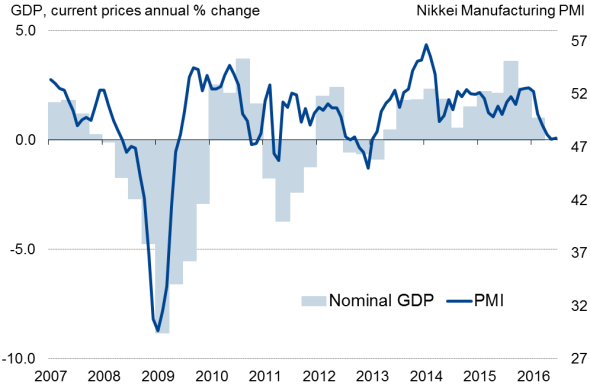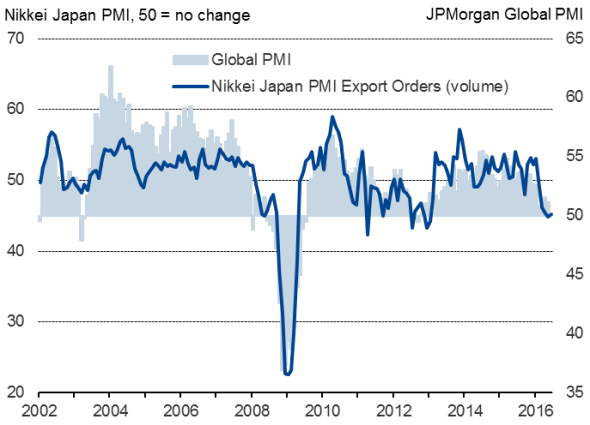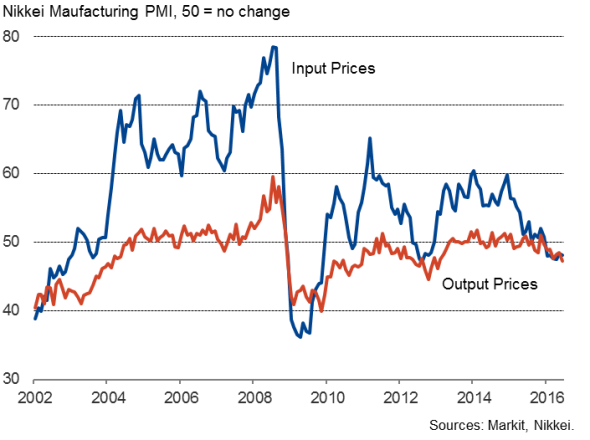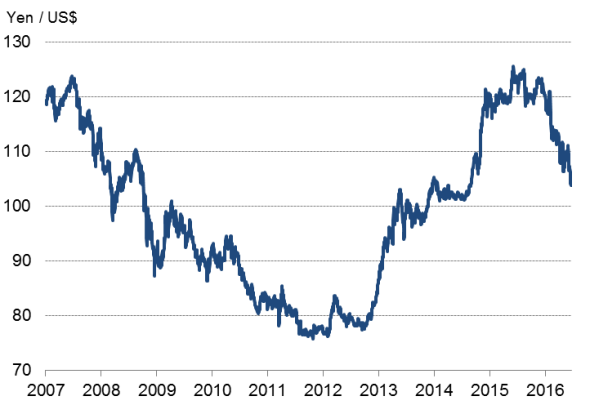Japan flash manufacturing PMI adds to economic growth worries
PMI data suggest that the Japanese manufacturing economy remained mired in a renewed downturn in June, with the survey also flashing warning signs about potentially persistent weak growth moving into the second half of the year.
Nikkei Manufacturing PMI v nominal GDP*

* The headline manufacturing PMI is a composite indicator derived from survey questions on output, new orders, employment, inventories and suppliers' delivery times. As such, the PMI gives a broad indication of the health of the manufacturing economy each month but also gives a reliable steer on the performance of the wider economy.
Second quarter downturn
The Nikkei Flash Japan Manufacturing PMI* rose only modestly from the near three-and-a-half year low of 47.7 seen in May, edging up to 47.8. The latest reading signalled a fourth successive monthly deterioration in manufacturing business conditions, with the second quarter average running at the lowest since the fourth quarter of 2012.
As our first chart shows, in recent years when the PMI has fallen to its current low levels it has soon been followed by a decline in nominal GDP.
The data therefore suggest that the improvement in economic performance seen in the first quarter, for which economic growth was revised higher to an annualised rate of 1.9%, will be followed by a renewed downturn.
Anecdotal evidence given by PMI survey participants indicates that the weakening in part reflect ongoing supply chain disruptions following April's earthquakes. Faster growth is therefore anticipated for the second half of the year as manufacturing supply chains return to normal.
Japan exports v global PMI

Rebound worries
Some caution is warranted here, however. Supplier lead times deteriorated only modestly in May after the recent earthquakes (contrasting markedly, for example, with the severe disruptions signalled in 2011), suggesting supply chain disruptions are only a minor factor in the recent slowdown.
Survey responses also highlight other factors which are subduing manufacturing growth, suggesting any rebound may prove disappointing.
Weak demand in overseas markets was also seen as a key factor reducing exports again in June, and we note that global economic growth has slowed to a three-and-a-half year low in recent months, according to the global PMI.
The impact of sluggish global growth has also been exacerbated by a 15% rise in the yen against the US dollar so far this year, making Japanese goods more expensive in overseas markets.
A persistent strength of the yen and subdued global demand could therefore inevitably curb any rebound fuelled by supply chains returning to normal.
Finally, the June PMI showed factory employment growth slowing to a near-standstill, suggesting firms have become increasingly cautious in their hiring amid signs of weak demand.
Prices fall at increased rate
The second quarter slowdown in the economy signalled by the PMI and the warning signals for coming months will clearly disappoint policymakers, as will the drop in prices signalled by the flash PMI. Producers reported the steepest fall in prices charged for goods since January 2013, due in part to further falls in imported input costs.
The government has set a target of achieving a 2% inflation rate by March 2018, but the key measure of core inflation dropped to 0.9% in April compared to 1.1% in March and the PMI points to further downward pressures on inflation.
Producer prices

Gloomier outlook
Growth is expected to benefit next year from the postponement of the government's planned sales tax hike as well as further planned but as yet unspecified fiscal stimulus. However, the news of the delayed tax hike merely meant forecasts of a near-stagnation in the economy next year have been revised up to still-modest 1% growth or less in some cases.
Clearly the risk of a renewed recession therefore remains high. If June's weak manufacturing numbers are followed by disappointing services PMI numbers, there's a strong chance that the central bank will seek to inject further stimulus.
The Bank of Japan decided to keep policy unchanged in June, despite also downgrading its forecast for inflation and seeing disappointingly weak global demand. The bank cited the need for caution as international markets were being shaken by 'Brexit' uncertainty.
Interest rates are at minus 0.1% and the bank is buying "80 trillion ($760bn) of assets per year.
Stronger yen

Chris Williamson | Chief Business Economist, IHS Markit
Tel: +44 20 7260 2329
chris.williamson@ihsmarkit.com
